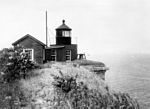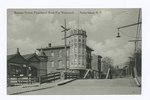National American Indian Memorial
1913 in the United StatesColossal statues in the United StatesHistory of New York CityHistory of Staten IslandMonuments and memorials in New York City ... and 4 more
Native American topicsProposed monuments and memorials in the United StatesSculptures of Native AmericansUnbuilt buildings and structures in New York City

The National American Indian Memorial or North American Indian Memorial was a proposed monument to Native Americans to be erected on a bluff overlooking the Narrows, the main entrance to New York Harbor. The major part of the memorial was to be a 165-foot-tall (50 m) statue of a representative American Indian warrior atop a substantial foundation building housing a museum of native cultures, similar in scale to, but higher than, the Statue of Liberty several miles to the north. Ground was broken to begin construction in 1913 but the project was never completed and no physical trace remains today.
Excerpt from the Wikipedia article National American Indian Memorial (License: CC BY-SA 3.0, Authors, Images).National American Indian Memorial
Tompkins Street, New York Staten Island
Geographical coordinates (GPS) Address Nearby Places Show on map
Geographical coordinates (GPS)
| Latitude | Longitude |
|---|---|
| N 40.604944444444 ° | E -74.056555555556 ° |
Address
Fort Tompkins
Tompkins Street
10305 New York, Staten Island
New York, United States
Open on Google Maps








